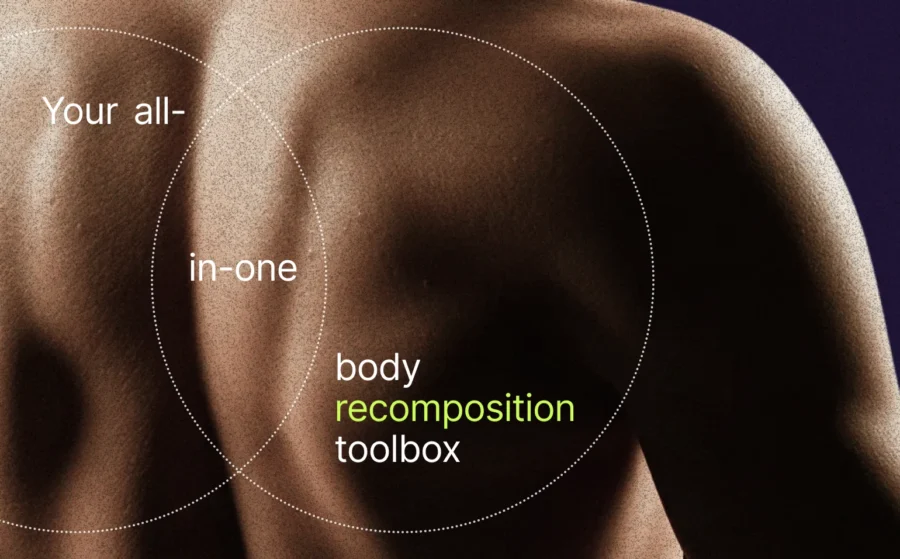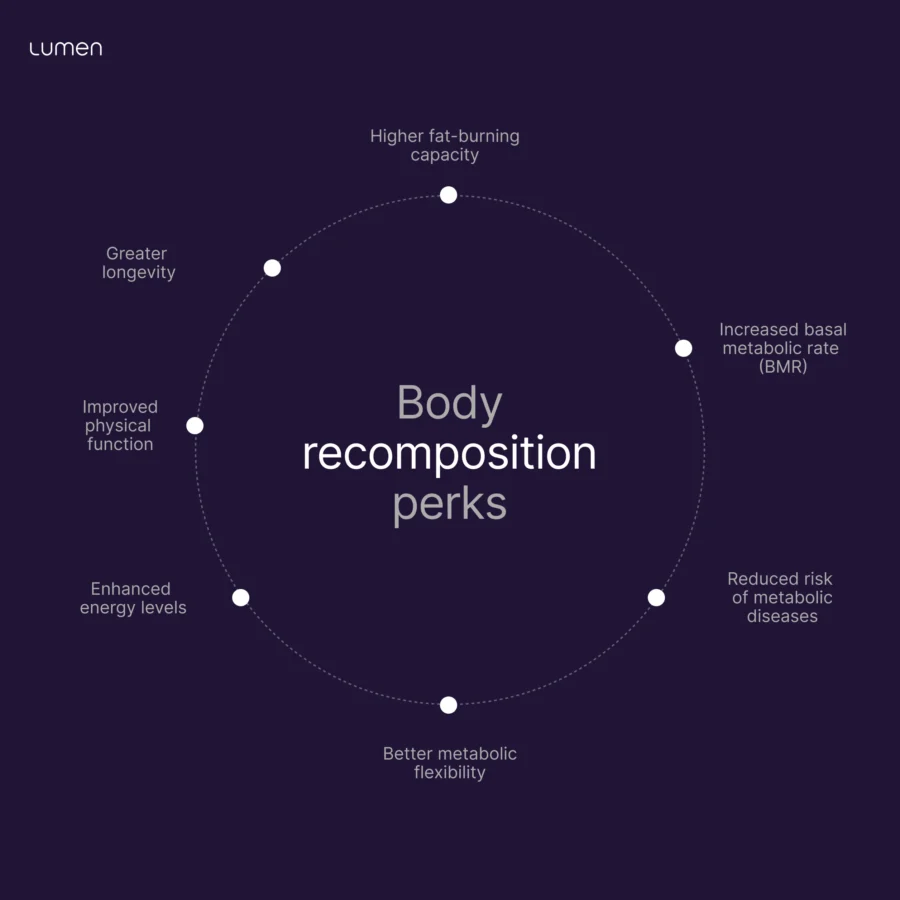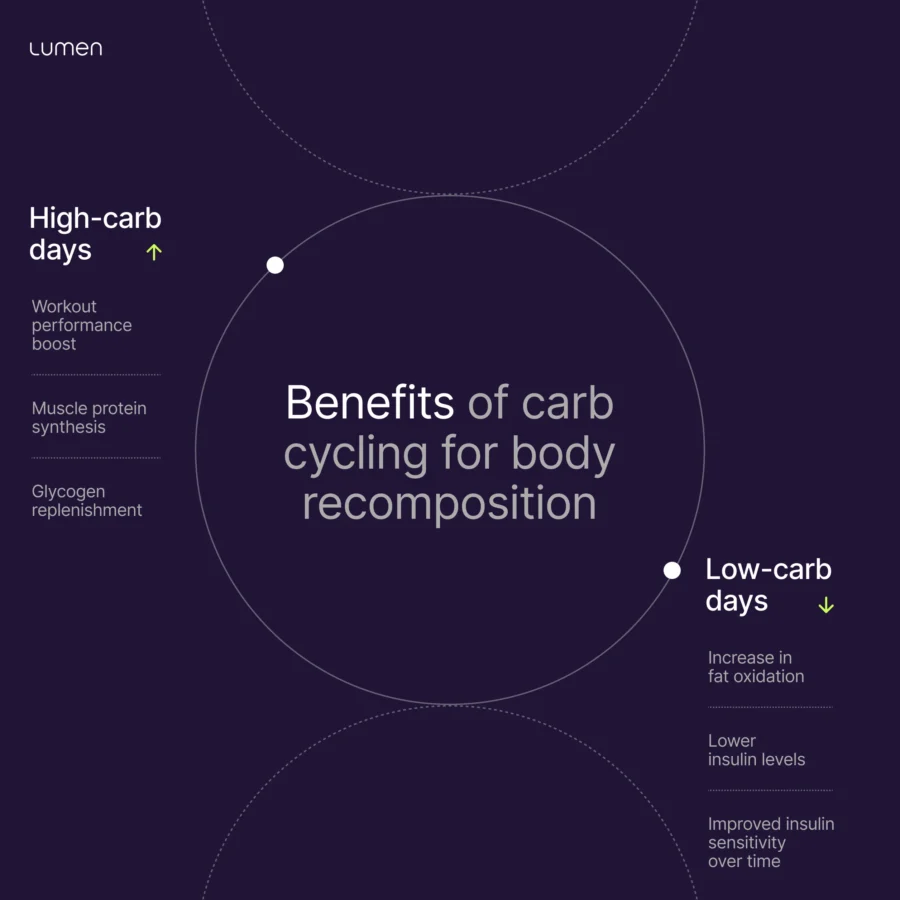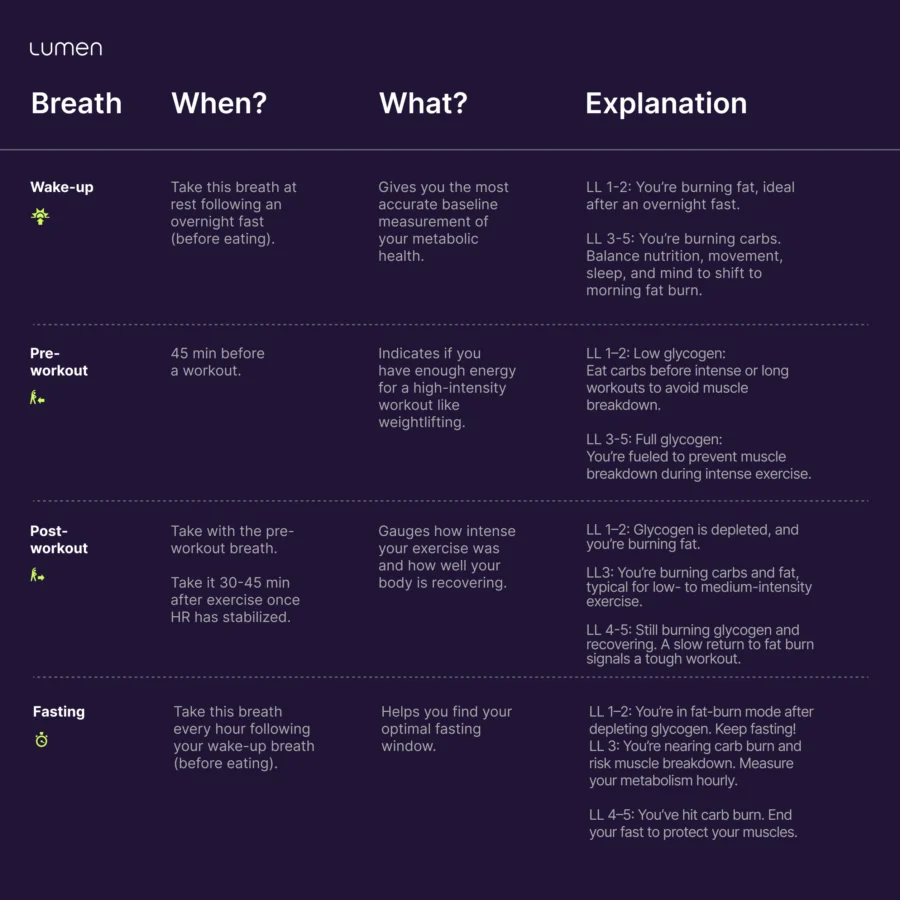Your all-in-one body recomposition toolbox

In any weight loss journey, losing a bit of muscle mass along with fat is common and inevitable. It’s even more common with extreme calorie restriction, excessive exercising, over-fasting, weight loss medications, and imbalanced macronutrient intake.
But here’s the real kicker: As muscle mass diminishes, so does the amount of mitochondria, the powerhouses in your cells responsible for turning carbs and fats into energy. This affects how much fat you burn at rest and can slow your metabolism, as your basal metabolic rate (BMR) and total energy expenditure (TDEE) decrease.
Losing muscle mass also drives down glycogen, your body’s storage form of carbs. Maintaining larger glycogen stores is a perk because your muscles can efficiently use carbs when you need an energy boost, ensuring less glucose is stored as fat.
If you want the best of both worlds — losing fat while gaining muscle — body recomposition is your answer. Read on for an overview of how body recomposition works and how it can fit into your wellness toolbox.

All the perks of body recomposition
Increasing muscle mass and reducing body fat have numerous health benefits that can positively impact your well-being and long-term health:
- Higher fat-burning capacity: Muscle tissue is metabolically active and burns more calories than fat tissue, even during periods of rest. This results in a higher fat-burn rate.
- Increased basal metabolic rate (BMR): Increased muscle mass boosts your BMR, meaning you burn more calories at rest, which helps with weight management [1].
- Reduced risk of metabolic diseases: Lower body fat, particularly abdominal fat, reduces the risk of developing metabolic syndrome, type 2 diabetes, and cardiovascular diseases. Moreover, excess fat around the abdomen is strongly linked to systemic inflammation and insulin resistance [2].
- Better metabolic flexibility: Individuals with higher muscle mass tend to have greater metabolic flexibility, meaning their bodies can efficiently switch between burning carbohydrates and fats for energy depending on activity levels and dietary intake.
- Enhanced energy levels: More muscle mass contributes to greater stamina and reduced fatigue, as muscles efficiently store and utilize glycogen for sustained energy.
- Improved physical function: Increased muscle mass enhances strength, mobility, and functional performance, reducing the risk of injury and improving quality of life, especially as we age.
- Greater longevity: Maintaining a healthy muscle-to-fat ratio is linked to a longer lifespan, reduced inflammation, and improved immune function [3, 4, 5].
What triggers fat burn?
Fat burn, or fat oxidation, is the process by which stored fat is broken down into glycerol and free fatty acids and used as energy.
This process can be triggered by various factors, including fasting, low-moderate physical activity, and being in a moderate caloric deficit.
During prolonged low-intensity aerobic exercise, such as zone 2 walking, your mitochondria typically use fat for fuel, which is effective for increasing fat burn. Burning more calories than consumed also promotes fat oxidation by encouraging the body to use stored fat as its primary energy source, especially when glycogen levels have been depleted.
Several hormones enhance fat oxidation, especially during fasting or exercise. Catecholamines (adrenaline and noradrenaline) stimulate the breakdown of triglycerides [6]. Glucagon, released during fasting or low-carbohydrate states, promotes fat utilization. Growth hormones also contribute to fat store mobilization, further enhancing the body’s ability to oxidize fat for energy [7].
What’s better for fat burn: Moderate calorie restriction or exercise?
The best approach is a balanced one that you can sustain long term. This includes pairing a moderate caloric deficit with regular exercise, such as resistance training. This promotes fat loss while preserving lean body mass.
Optimizing your macronutrient intake by prioritizing high-protein levels can also help you preserve muscle mass while in a deficit and enhance satiety.

What maximizes your muscle gains?
Muscle hypertrophy refers to the growth and increase in muscle fiber size and results from a combination of physical activity, nutrition, and recovery.
Resistance training is the primary driver, with mechanical tension, muscle damage, and metabolic stress stimulating growth. Progressive overload, where weight, reps, or intensity are gradually increased, ensures continued adaptation.
Proper nutrition is critical, with adequate protein intake supporting muscle growth and repair and carbohydrates providing energy and glycogen replenishment. A slight caloric surplus can enhance muscle growth and recovery for bodybuilders or individuals only interested in muscle gain.
Hormones, such as testosterone, growth hormone, and insulin, also promote protein synthesis and recovery [8].
Finally, rest and recovery, including sufficient sleep, are essential for muscle repair and sustained muscle hypertrophy.
How much protein should you eat to build muscle?
Optimal protein intake for muscle gain varies depending on an individual’s weight, activity level, and overall goals. Research suggests that healthy people engaging in regular resistance training or other forms of exercise should consume 1.6–2.2 grams of protein per kilogram of body weight per day.
This range ensures sufficient amino acids to support muscle repair and growth while maximizing the benefits of strength training. Those with higher activity levels or in a caloric deficit may benefit from staying toward the upper end of this range to preserve muscle mass.
How do carbs fit into the picture?
Balancing your calorie intake and adjusting carbohydrate consumption based on your metabolic state and activity level are essential for gaining muscle while minimizing fat gain.
Using a metabolic tracker can help you determine the right ratio of macronutrients to include in your daily nutrition plan and whether to eat low- or high-carb based on your real-time metabolic measurements.
A metabolic tracker can also provide strategies for optimal carb timing and functional nutrition to optimize body recomposition and metabolic flexibility.

The benefits of carb cycling for body recomposition
When timed with weight training days, higher carb intake provides several benefits:
- Enhanced workout performance: Carbohydrates are the body’s preferred fuel source for high-intensity exercise like weightlifting. Having more glycogen stores available helps maintain intensity during weight training sessions, potentially allowing for more volume and better performance. This targeted approach also ensures your body has the fuel it needs to build muscle, not break it down.
- Improved muscle protein synthesis: The insulin spike from carbohydrates helps shuttle nutrients into muscle cells. Combined with the muscle damage from weight training, this creates an optimal environment for muscle growth and recovery.
- Glycogen replenishment: Since your insulin sensitivity is high around 45 minutes after a workout, it’s recommended that you eat carbs within this window, as they’re more likely to replenish glycogen stores rather than be stored as fat.
On rest and recovery days, reducing carb intake can:
- Improve fat oxidation as your body depletes its glycogen stores, and lower insulin levels allow better access to fat stores.
- Improve insulin sensitivity over time.
Why prolonged low-carb or keto diets don’t work if you want to gain muscle mass
Prolonged low-carb or keto diets provide minimal carbohydrates, significantly limiting glycogen replenishment between workouts.
Because glycogen is the primary fuel source for high-intensity exercise and resistance training, it is essential for muscle growth.
Without sufficient glycogen, you risk muscle breakdown, and workout performance and recovery may suffer. This makes it more challenging to effectively stimulate and sustain muscle growth.
The best exercises for body recomposition
The best exercises for body recomposition combine strength training and low-intensity cardio to build muscle while reducing body fat. Strength training is essential for preserving and building lean muscle mass.
Incorporating compound movements like squats, deadlifts, bench presses, and rows ensures maximum muscle engagement and efficiency. Just ensure you’re doing enough reps to reach muscle fatigue and are applying progressive overload for continued adaptation.
For cardio, the focus should be on low- to moderate-intensity sessions to support fat loss. Activities like brisk walking, cycling, or steady-state jogging are effective. The key is balancing both types of exercise with proper nutrition and recovery to optimize results.
Debunking myths around weight gain from body recomposition
The scale is not the most reliable progress tracker during body recomposition. Fat loss and muscle gain can offset each other, keeping the number on the scale stable or even causing a slight weight increase. This is because muscle is denser than fat, meaning it takes up less space for the same weight.
Instead of fixating on the scale, focus on more meaningful indicators of progress, such as improved workout performance, higher energy levels, how your clothes fit, and, when available, body composition measurements.
How metabolic flexibility can help you reach your body recomposition goals
Metabolic flexibility allows your mitochondria to efficiently switch between using carbs and fats for energy, depending on the demand. This balance helps you tap into carbs from food and glycogen stores for energy while supporting lean mass development. Additionally, it enhances fat utilization at optimal times, promoting body fat reduction and improving body composition.
The good news is your metabolic flexibility isn’t static. You can boost it with a metabolic tracker like Lumen. By considering your daily morning metabolic state from your wake-up breath measurement, Lumen adjusts your macro split through a smart carb-cycling approach to guide you toward optimal metabolic flexibility and support your body recomposition efforts.
In addition to your real-time metabolic measurements, Lumen also considers age, gender, height, weight, hormones, health goals, activity level, and dietary preferences to provide a tailored nutrition plan and lifestyle strategies.
Measuring your pre- and post-workout breath and fasting breath can also support your body recomposition goals.
Wake-up breath
Your wake-up breath gives you the quickest and most accurate look at whether or not your lifestyle is well-balanced and what you can do to keep your metabolism on track. Waking up in fat burn is the goal. It’s a sign of balance between the four major areas of your lifestyle: nutrition, movement, sleep, and stress management.
Healthy mitochondria burn fat at rest and while fasting, which is why we aim to wake up in fat-burn mode. Waking up in carb burn can be due to a few reasons related to your lifestyle, such as late-night eating, not getting enough sleep, and stress. If you’re noticing your fat burn is lagging, try tracking your wake-up breath to spot any patterns.
Pre-workout breath
Indicates if you have enough carbs in your system — from food or glycogen stores — to support a high-intensity workout like weightlifting. If you’re burning mostly carbs, this can indicate full glycogen stores, which can support an effective high-intensity workout.
If you’re burning fats before weightlifting, then your glycogen stores might be empty. That’s your sign to grab a high-carb snack to support your workout and prevent muscle breakdown.
Post-workout breath
Taken 30 minutes after a workout, your post-workout breath reveals the impact of your workout on your body, assessing glycogen status and providing nutritional guidance on replenishing it for optimal recovery and muscle growth.
Fasting breath
Measuring your fasting breath helps you figure out exactly how long to intermittent fast so you can push into fat burn and avoid over-fasting, which can cause your body to break down muscle for energy.
All you have to do is take your wake-up breath and continue measuring your metabolism every 1-2 hours while still in a fasted state. If you’ve shifted into fat burn, this indicates your glycogen stores are emptying, and you are in your fasting sweet spot. If you take another measurement an hour later and have reached carb burn, that’s your cue to break your fast and eat something nutritious to avoid muscle breakdown.

Body recomposition meal plans
More body recomposition resources
- How to get enough protein: An RD weighs in
- How metabolic flexibility can boost your weightlifting endurance
- Get to know your carbs: How they fit into a healthy diet
- Walking for weight loss
Body recomposition for the win-win
To optimize body recomposition, it’s essential to maintain a balanced approach that includes a moderate caloric deficit paired with resistance training. This helps preserve and build muscle mass while promoting fat loss.
Proper macronutrient intake, especially high protein levels, is crucial for maintaining muscle mass, reducing hunger, and supporting muscle recovery. Additionally, carb cycling, where carbohydrate intake is adjusted based on activity levels, can be beneficial. Higher carbs on training days support workout performance and muscle growth, while lower carbs on rest days promote fat oxidation.
Improving your metabolic flexibility with tools like Lumen further supports these goals by enhancing fat and carb burn and supporting muscle building and recovery.
Sources
[1]Cunningham J. J. (1991). Body composition as a determinant of energy expenditure: a synthetic review and a proposed general prediction equation. The American journal of clinical nutrition, 54(6), 963–969. https://doi.org/10.1093/ajcn/54.6.963
[2] McCarthy, D., & Berg, A. (2021). Weight Loss Strategies and the Risk of Skeletal Muscle Mass Loss. Nutrients, 13(7), 2473. https://doi.org/10.3390/nu13072473
[3] Srikanthan, P., & Karlamangla, A. S. (2014). Muscle mass index as a predictor of longevity in older adults. The American journal of medicine, 127(6), 547–553. https://doi.org/10.1016/j.amjmed.2014.02.007
[4] Fernández-Sánchez, A., Madrigal-Santillán, E., Bautista, M., Esquivel-Soto, J., Morales-González, A., Esquivel-Chirino, C., Durante-Montiel, I., Sánchez-Rivera, G., Valadez-Vega, C., & Morales-González, J. A. (2011). Inflammation, oxidative stress, and obesity. International journal of molecular sciences, 12(5), 3117–3132. https://doi.org/10.3390/ijms12053117
[5] Andersen, C. J., Murphy, K. E., & Fernandez, M. L. (2016). Impact of Obesity and Metabolic Syndrome on Immunity. Advances in nutrition (Bethesda, Md.), 7(1), 66–75. https://doi.org/10.3945/an.115.010207
[6] Reilly, S. M., Hung, C. W., Ahmadian, M., Zhao, P., Keinan, O., Gomez, A. V., DeLuca, J. H., Dadpey, B., Lu, D., Zaid, J., Poirier, B., Peng, X., Yu, R. T., Downes, M., Liddle, C., Evans, R. M., Murphy, A. N., & Saltiel, A. R. (2020). Catecholamines suppress fatty acid re-esterification and increase oxidation in white adipocytes via STAT3. Nature metabolism, 2(7), 620–634. https://doi.org/10.1038/s42255-020-0217-6
[7] Ottosson, M., Lönnroth, P., Björntorp, P., & Edén, S. (2000). Effects of cortisol and growth hormone on lipolysis in human adipose tissue. The Journal of clinical endocrinology and metabolism, 85(2), 799–803. https://doi.org/10.1210/jcem.85.2.6358[8] Rooyackers, O. E., & Nair, K. S. (1997). Hormonal regulation of human muscle protein metabolism. Annual review of nutrition, 17, 457–485. https://doi.org/10.1146/annurev.nutr.17.1.457
[8] Rooyackers, O. E., & Nair, K. S. (1997). Hormonal regulation of human muscle protein metabolism. Annual review of nutrition, 17, 457–485. https://doi.org/10.1146/annurev.nutr.17.1.457







 Digital download
Digital download 